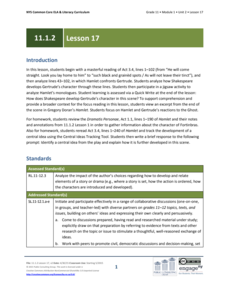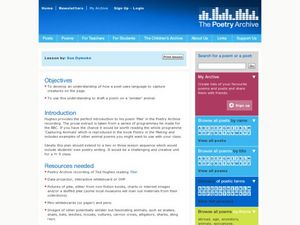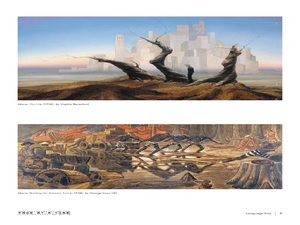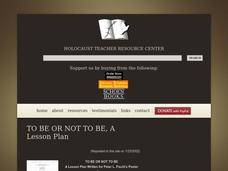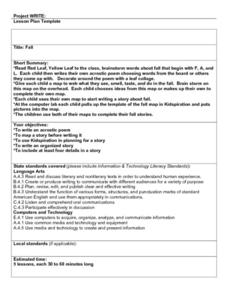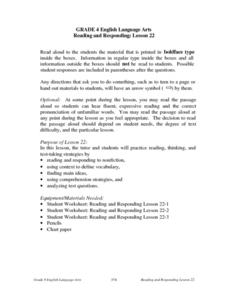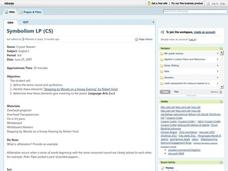Reed Novel Studies
Rules: Novel Study
Have you ever been so focused on others, that a look in the mirror surprises you? It seems that Catherine, a character in Rules, does just that when she focuses so much on her autistic brother's behaviors that she is surprised by her own...
Literacy Design Collaborative
In Pursuit of Happiness
What ideas and philosophies guided the Transcendentalist movement in America? Scholars explore the topic, reading texts by Ralph Waldo Emerson and Henry David Thoreau. Additionally, they write essays comparing the authors' structural...
EngageNY
Grade 10 ELA Module 4: Unit 2, Lesson 4
Ambition, murder, nontraditional gender roles ... some problems just can't be fixed in marriage counseling. Learners discuss the relationship between Macbeth and Lady Macbeth. As a culminating activity, pupils analyze how the characters'...
EngageNY
Grade 11 ELA Module 1: Unit 2, Lesson 17
Why is Hamlet so upset with Gertrude? Using the resource, scholars read Act 3.4 of Hamlet, analyzing how Shakespeare develops Gertrude's character in the scene. Next, pupils participate in a jigsaw activity to discuss Hamlet's monologues.
Voices of a People's History
Voices in The Classroom
Everyone's perspective of the past is different. A thought-provoking unit gives young academics the opportunity to explore their perspectives on history and their neighborhoods. Based on the work of Howard Zinn, each lesson explores...
EngageNY
Coda: What Gives This Story Power? Re-Examining Powerful Stories
Writers consider what makes a story powerful as they listen to a short story about Frederick Douglass. Once finished, small groups complete a worksheet to analyze what makes the story so enduring.
National Park Service
Lesson 5: Coded Spirituals, Metaphor in African Spirituals
If a picture is worth a thousand words, song lyrics also can communicate many meanings. Using the lyrics of spirituals, young historians analyze them for coded messages about freedom. Resources include a chart to help individuals track...
Smithsonian Institution
A Dream Deferred: DACA
"Give us your tired, your poor, your huddled masses" has even more meaning for some children. The resource explores the Deferred Action for Childhood Arrivals (DACA) program. Scholars analyze primary sources and participate in group...
Center for History Education
Who Fired the Shot Heard Round the World?
Take a closer look. Young academics become detectives in an engaging lesson on the American Revolution. Scholars work in groups to analyze documents to uncover whether the American colonists or British soldiers fired the first shot at...
Curated OER
The Search for Character!
Fifth graders define character words, look for real-life examples of the traits "in action," and write an acrostic poem based on one of these qualities.
Curated OER
Emily Dickinson & Poetic Imagination: "Leap, plashless"
Learners analyze the poems of Emily Dickinson and write their own nature poem. In this poetry analysis lesson, students read Dickinson poetry and analyze the use of imagery, sound, and metaphor. Learners write their own nature poem using...
Curated OER
Ted Hughes "Pike"
Students analyze how a poet uses language to capture creatures and draft a poem on a 'sinister' animal. In this poetry analysis lesson, students read Ted Hughes' poem 'Pike' and analyze pictures of pike fish. Students use their research...
Curated OER
Art Analysis and Creative Writing
Students write an acrostic poem and analyze a work of art. In this art lesson plan, students look at a picture and answer questions about it, write a poem, write about the setting in the painting they saw, and answer short questions...
Curated OER
Historical Maryland Women
Students identify objects, activities, and people in pictures of women in Maryland's history. In groups of four, they analyze photo packets of historical women. Students complete an acrostic using phrases reflecting specific...
Curated OER
Henry Wadsworth Longfellow's "Haunted Houses"
Learners read and analyze Henry Wadsworth Longfellow's poem, "Haunted Houses." They define key vocabulary terms, discuss the poem's technical aspects, and create an original poem about a haunted house or a haunted place.
Curated OER
Jabberwocky Lesson Plan
Young scholars complete a review of the parts of speech using a jabberwocky poem format. In this parts of speech and poetry lesson, students read a jabberwocky poem and identify parts of speech in the poem. Young scholars list...
Curated OER
To Be Or Not To Be
Students read the poem "To the Little Polish Boy Standing With His Arms Up." They discuss the poem. Students define the term "prejudice." They comapre and contrast the boy in the poster with the author of the poem, Peter Fischl. ...
Curated OER
Fall
Pupils read "Red Leaf, Yellow Leaf" then they brainstorm words about fall that begin with the letters F, A, and L. They compose and decorate their own acrostic poem then they write a Fall story and complete a final copy in the computer lab.
Curated OER
Reading and Responding
Fourth graders read and respond to poetry. They identify the author's purpose and connect the literature to their personal experiences. Students critically analyze the poem and write a poem of their own.
Curated OER
The Road Not Taken
Young scholars analyze Robert Frost's poem "The Road Not Taken." In this poem analysis lesson, students review vocabulary for the poem and read the poem. Young scholars discuss the meanings in each stanza, the theme, and its rhyme...
Curated OER
Symbolism Lesson Plan
Students define the terms symbolism and mood. In groups, they read a poem by Robert Frost and identify the concepts in the poem. As a class, they discuss how the two elements give a meaning to the writing. They also give their own...
Curated OER
Out of the Dust
Seventh graders read a book of poems called "Out of the Dust". In groups, they research the Dust Bowl and how it affected people living through the Great Depression. Using the text, they identify the theme and key turning points and...
Curated OER
Eight Lines about home
Students brainstorm positive things about their city and write an eight line poem about it.
Curated OER
"Thank You Ma'am" by Langston Hughes
Students use Langston Hughes' "Thank You Ma'am" as a reading and vocabulary improvement activity. In this reading and vocabulary lesson, students review the related vocabulary and read the poem. Students discuss the story elements in the...
Other popular searches
- Analyze Poetry
- Analyze Poetry Third Grade
- Analyze Symbolism in Poetry
- How to Analyze Poetry
- Analyze Imagery in Poetry





